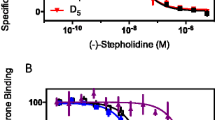Summary
1. Our aim was to test the hypothesis that selectivity for D3 dopamine (DA) receptors may contribute to limbic anti-DA selectivity ofS-(+)-aporphine DA partial agonists.
2. Affinity was tested with3H-emonapride, using human D3 receptors in mouse fibroblasts and D2 receptors in rat striatal tissue.
3. D3 receptors showed a picomolar affinity for3H-emonapride, Na+ dependence, and reversible saturability, as well as stereoselectivity. Confirmatory or novel D3/D2 pharmacologic selectivity was found with several benzamides, thioxanthenes, buspirone, GBR-12909, and DA agonists including hydroxyaminotetralins [ADTN, (+)-7-OH-DPAT, (−)-PPHT and its fluorescein derivative], (−)-N-propylnorapomorphine, (−)-3-PPP, (−)-quinpirole, and SDZ-205-502, but neither aminoergoline nor (+)-aporphine partial agonists.
4. The results extend pharmacologic characterization of D3-transfected cell membranes but fail to account for the high limbic anti-DA selectivity ofS-(+)-aporphines.
Similar content being viewed by others
References
Baldessarini, R. J., Kula, N. S., Campbell, A., Bakthavachalam, V., Yuan, J., and Neumeyer, J. L. (1992). Prolonged D2 antidopaminergic activity of alkylating and nonalkylating derivatives of spiperone in rat brain.Mol. Pharmacol. 42856–863.
Baldessarini, R. J., Kula, N. S., McGrath, C., Kebabian, J. W., and Neumeyer, J. L. (1993). Isomeric selectivity of D3 dopamine receptors.Eur. J. Pharmacol. 239269–270.
Boundy, V. A., Luedke, R. R., Gallitano, A. L., Smith, J. E., Filtz, T. M., Kallen, R. G., and Molinoff, P. B. (1993). Expression and characterization of the rat D3 dopamine receptor: Pharmacologic properties and development of antibodies.J. Pharmacol. Exp. Ther. 2641002–1011.
Bouthenet, M. L., Souil, E., Martres, M. P., Sokoloff, P., Giros, B., and Schwartz, J. C. (1991). Localization of dopamine D3 receptor mRNA in the rat brain using in situ hybridization biochemistry: Comparison with dopamine D2 receptor mRNA.Brain Res. 564203–219.
Campbell, A., Yeghiayan, S., Baldessarini, R. J., and Neumeyer, J. L. (1991). Selective antidopaminergic effects of S(+)-N-n-propylnoraporphines in limbic vs. extrapyramidal sites in rat brain: Comparisons with typical and atypical antipsychotic agents.Psychopharmacology 103323–329.
Campbell, A., Baldessarini, R. J., and Yeghiayan, S. (1992). Antagonism of limbic and extrapyramidal actions of intracerebrally injected dopamine by ergolines with partial D2 agonist activity in the rat.Brain Res. 592348–352.
Campbell, A., Baldessarini, R. J., and Neumeyer, J. L. (1993). Altered spontaneous behavior and sensitivity to apomorphine in rats following pretreatment with S(+)-aporphines or fluphenazine.Psychopharmacology 111351–358.
Figur, L. M., Evans, D. L., Stratman, N. C., and Lahti, R. A. (1992). The dopamine D4 and D2 receptors: Comparison of neuroleptic binding activities.Soc. Neurosci. Abstr. 18375.
Foulon, C., Kung, M. P., and Kung, H. F. (1993). Synthesis of (R,S)-2′-trans-7-hydroxy-2-[N-n-propyl-N-(3′-iodo-2′-propenyl)amino]tetralin (Trans-7-OH-PIPAT): A new D3 dopamine receptor ligand.J. Med. Chem. 361499–1500.
Kebabian, J. W., and Calne, D. B. (1979). Multiple receptors for dopamine.Nature 22793–96.
Landwehrmeyer, B., Mengod, G., and Palacios, J. M. (1993). Differential visualization of dopamine D2 and D3 receptor sites in rat brain: a comparative study using in situ hybridization histochemistry and ligand binding autoradiography.Eur. J. Neurosci. 5145–153.
Lévesque, D., Diaz, J. Pilon, C., Martres, M. P., Giros, B., Souil, E., Schott, D., Morgat, J. L., and Schwartz, J. C. (1992). Identification, characterization, and localization of the dopamine D3 receptor in rat brain using 7-[3H]hydroxy-N,N-di-n-propyl-2-aminotetralin.Proc. Natl. Acad. Sci. USA 898155–8159.
Leysen, J. E., Janssen, P. M., Schotte, A., Luyten, W. H., and Megens, A. A. (1993). Interaction of antipsychotic drugs with neurotransmitter receptor sites in vitro and in vivo in relation to pharmacological and clinical effects: Role of 5HT2 receptors.Psychopharmacology 112S40-S54.
Malmberg, Å., Jackson, D. M., Erikssonm, A., and Mohell, N. (1993). Unique binding characteristics of antipsychotic agents interacting with human dopamine D2A, D2B, and D3 receptors.J. Pharmacol. Exp. Ther. 43749–754.
Seabrook, G. R., Patel, S., Marwood, R., Emms, F., Knowles, M. R., Freedman, S. B., and McAllister, G. (1992). Stable expression of human D3 dopamine receptors in GH4C1 pituitary cells.Fed. Eur. Biochem. Soc. Lett. 312123–126.
Seeman, P., and Van Tol, H. H. (1993). Dopamine D4 receptors bind inactive (+)-aporphines suggesting neuroleptic role: Sulpiride not stereoselective.Eur. J. Pharmacol. 233173–174.
Sibley, D. R., Monsma, F., Jr., and Shen, Y. (1993). Molecular neurobiology of dopaminergic receptors.Int. Rev. Neurobiol. 35391–415.
Sokoloff, P., Giros, B., Martres, M. P., Bouthenet, M. L., and Schwartz, J. C. (1990). Molecular cloning and characterization of a novel dopamine receptor (D3) as a target for neuroleptics.Nature 347146–151.
Sokoloff, P., Andrieux, M., Besançon, R., Pilon, C., Martres, M. P., Giros, B., and Schwartz, J. C. (1992). Pharmacology of human dopamine D3 receptor expressed in a mammalian cell line: Comparison with D2 receptor.Eur. J. Pharmacol. 225331–337.
Tang, L., Todd, R. D., Heller, A., and O'Malley, K. (1994). Pharmacological and functional characterization of D2, D3, and D4 dopamine receptors in fibroblast dopaminergic cell lines.J. Pharmacol. Exp. Ther. 268495–502.
Todd, R. D., and O'Malley, K. L. (1993). Family ties: Dopamine D2-like receptor genes.RBI Neurotransmiss. 91–4.
Watts, V. J., Lawler, C. P., Knoerzer, T., Mayleben, M. A., Neve, K. A., Nichols, D. E., and Mailman, R. B. (1993). Hexahydrobenzo[a]phenanthridines: Novel dopamine D3 receptor ligands.Eur. J. Pharmacol. 239271–273.
Author information
Authors and Affiliations
Rights and permissions
About this article
Cite this article
Kula, N.S., Baldessarini, R.J., Kebabian, J.W. et al. S-(+)-aporphines are not selective for human D3 dopamine receptors. Cell Mol Neurobiol 14, 185–191 (1994). https://doi.org/10.1007/BF02090784
Received:
Accepted:
Issue Date:
DOI: https://doi.org/10.1007/BF02090784




